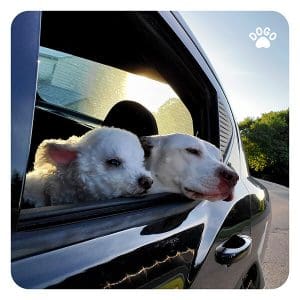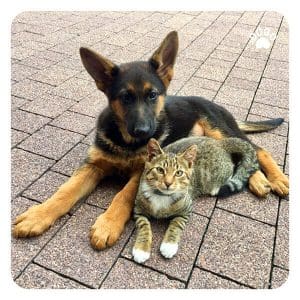 Socialization with the environment is professionally referred to as habituation. Every puppy is born with a set of genes, received from their parents. Among them, there are character traits and general attitude to life. These are the strong foundations of our four-legged friend that determine their mental resilience. However, for an animal to build their personality, they must open up to the reality around them. They explore the world and, based on experience, determine, among other things: what they like, what they don’t like, what is not allowed, and what they should rather beware of. Such experiences teach them the “rules of life”, and these ensure their survival. Read more to understand how to socialize your puppy with the environment.
Socialization with the environment is professionally referred to as habituation. Every puppy is born with a set of genes, received from their parents. Among them, there are character traits and general attitude to life. These are the strong foundations of our four-legged friend that determine their mental resilience. However, for an animal to build their personality, they must open up to the reality around them. They explore the world and, based on experience, determine, among other things: what they like, what they don’t like, what is not allowed, and what they should rather beware of. Such experiences teach them the “rules of life”, and these ensure their survival. Read more to understand how to socialize your puppy with the environment.
When a puppy is born
From birth to about 8 weeks of age, your puppy should be taught by their mother. Her job is to set a good example. The little one is happy to imitate her behaviour. While playing with their siblings, they learn to communicate with others. The mother makes sure to show the limits of biting. She also takes care of the discipline, therefore the puppy learns to respect other dogs.
If we take the dog away from their mother too early, the initial process of habituation will be disturbed. It can additionally result in serious behavioural problems.
When a puppy is ready for a new home
When a pup reaches 2 months of age, they are ready to move into a new home. However, this does not mean the end of the habituation. The mother cannot continue to be their life teacher, so this role comes down to the new parents.
Their task is to introduce the dog to an unfamiliar world. An adopted dog faces many unknown stimuli. It is a very difficult time for them. Pet parents should surround them with special care and compassion. The dog should feel safe. To provide them with mental stability, the rules of proper behaviour should be indicated.
When introducing a puppy to a new environment, it is essential to remember that they are likely to feel overwhelmed and anxious. Start by introducing them to one new thing at a time and give them plenty of time to get used to it. It is also important to create a safe and comfortable space for them that they can retreat to if they feel scared or overwhelmed. This could be a crate or a designated area in the house. Also, make sure to provide them with lots of positive reinforcement, such as treats, toys, and praise when they exhibit good behavior, to help them feel secure and build their confidence.
If you don’t know how to do this, look at the Dogo Program Basic Obedience. The program describes exactly how to introduce basic obedience commands.
The process of socialization with the environment lasts up to 16 weeks. This limit is strongly dependent on your four-legged friend’s breed. All experiences from this period determine the dog’s mental development. If the socialization process is not successful, the dog may have difficulties in social life. It can also limit the dog’s ability to learn new skills and cope with different situations.
What can you do to complete the socialization process?
There is a “Golden 12” rule so that you won’t miss anything. According to it, during the habituation your puppy should:
- Get to know 12 different places (e.g. a lake, river, meadow, forest, beach, other people’s house, staircase, elevator, car, veterinary office, nursing office). Also, leave them home alone 12 times a week (away from the family and other animals, for 5 – 45 minutes).
- Get to know 12 different people (e.g. children, elderly people, adults, the disabled, a person in a hood, hat, glasses, etc.).
- Get to know 12 different surfaces (e.g. paving, wood, parquet, carpet, grass, linoleum, tiles, sand, mud, puddle, etc.).
- Get to know 12 different objects (objects made of different materials, of different structures and shapes – e.g. metal keys, cardboard packaging, plastic bags, wooden objects, paper items, plush toys, ball, etc.).
- Get to know 12 different noises (e.g. doors opening, intercom, the sound of children playing, storm, rain, the barking of other dogs, the sound coming from TV, washing machine, vacuum cleaner, driving cars, etc.).
- Get to know 12 different fast-moving objects (e.g. cyclists, skaters, skateboarders, cars, runners, cats, squirrels, horses, cows, etc.).
- Face 12 different challenges (e.g. staircases, puddles, cardboard tunnels, etc.).
- Get to know 12 different types of touch (e.g. petting the head, chest, touching ears and paws, checking teeth, etc.).
- Taste the food in 12 different dishes (e.g. plastic or metal bowl, pot, pan, cup, mug, plate, etc.).
- Taste the food in 12 different places (e.g. living room, bedroom, kitchen, bathroom, laundry room, garage, backyard, home of others, etc.)
- Get to know 12 different dogs (playing with not dangerous dogs).
- Get to know 12 different accessories (e.g. braided collar, leather, muzzle, braces, long, short, etc.). When introducing such items, go to the Dogo Useful section and find out how to introduce accessories.
In addition to the “Golden 12” rule, there are several other things that you can do to help socialize your puppy. One important aspect is to expose them to different types of animals, such as cats, birds, and rabbits, so they learn to interact with other animals in a positive way. Additionally, you can take your puppy to different types of events and environments, such as busy city streets, parks, and crowded markets, to help them become comfortable in different situations. Finally, it is important to continue to socialize your puppy beyond the 16-week limit. Keep exposing them to new experiences throughout their life to keep them mentally stimulated and well-adjusted.


Puppy as a family member
Enroll your dog in the Dogo puppy program. Every day in the activities Dogo will suggest different socialization tasks for you and your dog, so your dog grows up friendly and self-confident.
When socializing your dog with their environment, remember to pay attention to their mental comfort. Watch their reactions and don’t force your dog to do anything they don’t want to do. Make sure to use positive reinforcement and be supportive. It will ensure your dog’s emotional stability, make their social accommodation easier and create an unbreakable bond between you.
[/fusion_text]



